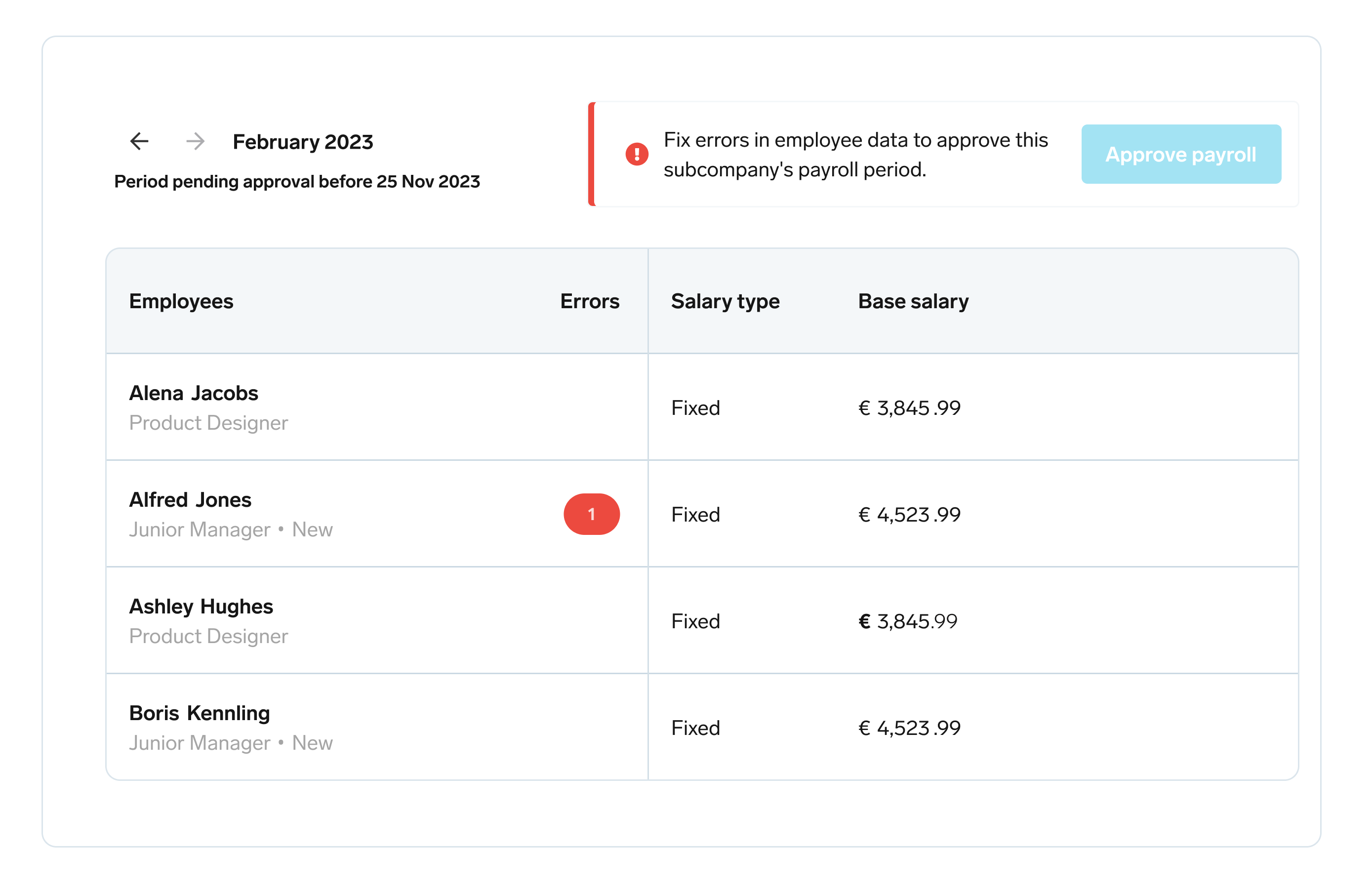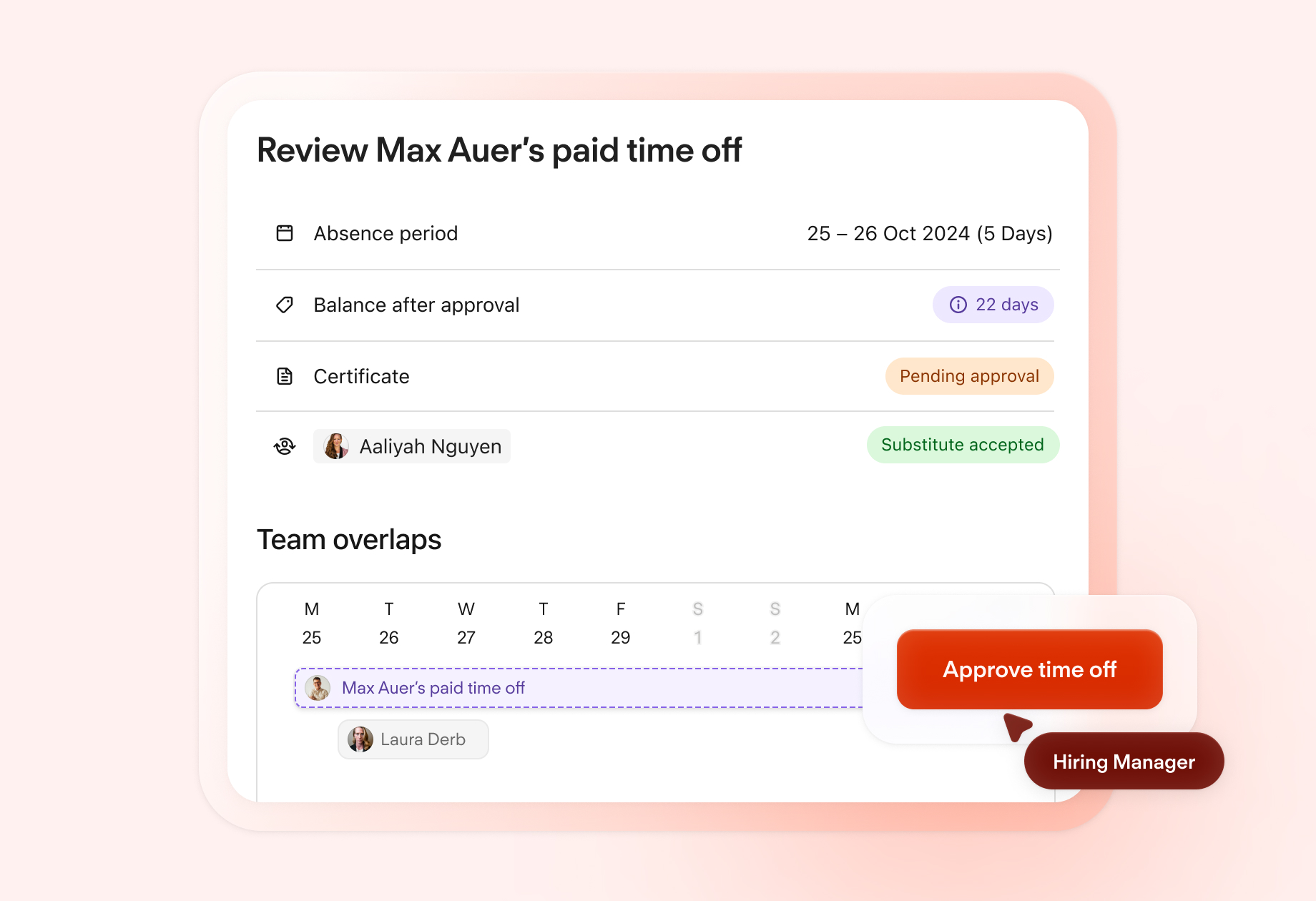
Start simplifying your payroll management
Learn how to streamline your payroll process to save time and ensure accuracy.
Read our guideLatest Blog Posts
The Complete Guide To UK Long-Term Sick Pay

When it comes to long-term sick pay in the UK, there's always a balance. It starts by having the right policies, complying with government legislation and being kind – but firm. Read on, to discover everything you need to know about long-term sickness in the UK.
Looking for a solution to track sick leave? Look no further than Personio.What is long-term sick pay?
Long-term sick pay is money paid by an organisation to an employee who is on sick leave for a longer period of time (most likely due to a health condition).
While it must meet the minimum statutory sick pay requirements, companies can choose to pay employees more for long-term sick pay and pay it out for longer than the mandated maximum of 28 weeks that the government states is necessary for SSP.
Is statutory sick pay (SSP) the same as long-term sick pay?
No. Not quite… It’s up to your company as to how much long-term sick pay is paid and how long you pay it for (as long as it meets the minimum SSP requirements)
As a reminder, in the UK, statutory sick pay (SSP) is paid to an employee who has been sick for four continuous days. During this time (up to 28 weeks), they can’t be forced to work.
Employees do earn and accrue statutory annual leave even while they’re off work sick – which they can also take during sick leave. But you can’t force them to take annual leave when they’re eligible for sick leave, according to gov.uk.
What is long-term sick leave?
The general consensus is that if someone is absent from work for four weeks or more, it’s considered to be long-term sickness. But, as the legal firm, Croner, explains, "The four weeks don’t have to be continuous. It’s possible to link periods if they last at least four days and are eight weeks apart or less." In other words, if a person is sick for at least four days, and they are sick multiple times within eight weeks or less, these can add up to four weeks over time.
This is important because even if an employee isn’t off sick for a single extended period, multiple longish absences can be a sign that they’re unwell.
When this happens, HR should support them to seek treatment or consider less stressful or onerous types of employment (for example, changing their working hours, environmental conditions, or by offering them an alternative job (with training) within your company).
What are the most common types of long-term sickness?
Before COVID, common causes of long-term illness included musculoskeletal injuries, acute medical conditions (such as cancer or heart attacks), stress, mental ill-health and back pain. Now, with long COVID and an increasing range of debilitating (but not necessarily life-threatening) auto-immune diseases, companies need to be even more aware of the effects of absence – on the company, and the employee.
According to research by the CIPD and Simplyhealth, “nearly four-fifths (79%) of respondents report some stress-related absence in their organisation over the last year (9% don’t know), although this rises to 91% of organisations with more than 250 employees.”
Manage Absences With Ease

Enable employees to quickly and efficiently apply for leave, automatically notifying their managers and marking them absent in their calendar once approved. Give HR a detailed overview of leave across the company.
Transform Your Absent ManagementWhat does UK law say about long-term sick pay?
In the UK, employers are required to pay them a minimum amount called Statutory Sick Pay (SSP) – for anything between four days and 28 weeks. It covers employees (not workers – read this blog post on employment status types to see the difference) who have worked for your company, earn an average of at least £120 per week and is payable for people who have been ill, or have been self-isolating for at least four days in a row (including non-working days).
The four-day period does not include a day they have spent at work if they have worked more than 1 minute before they go home sick. (If this happens, they would have to qualify for a second day). But the four-day period does include non-working days.
Employees may be eligible to receive £96.35 a week for SSP, up to 28 weeks. Employers pay this the same way they normally pay employees. (Note: gov.uk says you can reclaim up to two weeks’ SSP for employees who were off work on or before 30 September 2021, if they had COVID-19 or were self-isolating.)
What kind of long-term sick leave policy should you have in place?
A thorough one! The best policies are clear and easy for employers and managers to read, but also thorough enough to deal with a variety of circumstances. Really good policies also include examples to illustrate or clarify ambiguous circumstances.
A good long-term sickness policy should support your company culture and align with your business objectives. It should also explain your employees’ rights and obligations when they’re sick. Your policy should also include reference to SSP – but don’t forget, you can choose to pay more if you have a company sick pay scheme.
Beyond this, your long-term sickness policy should include details of what happens when an employee is sick, who they need to tell (and how quickly), when they need to provide evidence from a medical professional that they’re sick, and what happens if they’re sick for a long time.
For example – gov.uk explains that while employers can only ask for proof of sickness if they’re off work for more than 28 days in a row (including non-working days), the rules have changed recently. Now, if your employee started sick leave before 10 December 2021, you can ask for proof if they have been off work for more than seven days in a row (including non-working days). But your sickness policy may require employees to do this sooner.
You might want to include these elements (most of which are recommended by the CIPD) in your sickness policy:
Sick pay terms and SSP
Who to notify, and when
When they need a fit not or sick note (proof of sickness)
If you reserve the right to require them to get a report from their doctor
What happens when they come back to work (e.g. return-to-work interviews)
Whether and how you’ll help them get back to work ASAP (e.g. a phased return to work)
What happens if they’re ‘sick’ during major or adverse events (e.g. snow, COVID, during popular sporting events etc.)
Your stance on absenteeism
Your remote work policy (and what happens if employees are sick while working remotely)
How generous should companies make long-term sick pay?
Your company may choose to pay more long-term sick pay or pay it for a longer period. Whatever you choose, make sure it’s documented in the employment contract you have with your employees.
The longer an employee is away from work, the harder it often is for them to return. That’s why a lot of companies choose to adopt a phased return-to-work approach, as it eases employees back in – and makes it clear to them (and their colleagues) – what’s expected of them, and how they’ll be supported when they return.
How can organisations help employees on long-term sick leave?
Being away from work is stressful. But it’s less stressful for all concerned if your company has already thought through the implications of having employees off work due to long-term sickness. Here are some things that you can do to reassure sick employees, but there are many more:
Make it clear that they won’t lose their job even if they’re off sick (you can choose whether to define how long this will apply for, or not)
Explain if, and how, they’ll be supported to ease into their return (for example – you might want to engage or create an Employee Assistance Programme (EAP) to help provide advice and guidance
Talk about how their physical or mental challenges will be accommodated
Let them know if they can have someone to keep in touch with and reassure them while they’re away.
But don’t forget: having employees off work for a long time affects their colleagues, too.
Organisations that are supportive, generous and caring towards their employees during tough times will reap the rewards later and significantly reduce the pressure on employees to come back to work before they feel well. As a result, when employees do return to work they are more physically and mentally prepared, and able to do a better job.
Looking after employees while they’re sick, helping them feel supported, and getting them back to the work in the right way is the right thing to do for the vast majority of businesses.
How can organisations track long-term sickness?
You can record all absences in a ledger (if you’re living in the 20th century!) or on a spreadsheet. Or you can use tracking software that makes attendance tracking easy, is efficient and legally compliant, calculates things accurately and automatically, and lets you see your employees’ working hours at a glance. (We recommend the last option. But since we invented People Workflow Automation we are, admittedly a bit biased).
Can an employee be dismissed for long-term illness?
Yes. The government website says that “as a last resort, employers can dismiss an employee who is long-term sick”. But they do issue a few warnings about this. Remember – a dismissed employee can take you to an employment tribunal if they think they’ve been dismissed unfairly.
Before you dismiss an employee for being sick for a long time, it’s important to think about whether you can help them carry on working by being more flexible (for example: by varying their hours or making their job part-time), by reducing the amount of stress they’re under, or by helping them train to do less onerous work.
It’s also important to make sure that you’ve spoken with them about whether they think they will be able to return to work and establish if they think their health will improve.
What can HR do about long-term sick leave?
Considerate and caring employers will make sure that any signs of absenteeism or burnout are addressed promptly, and the route causes are identified. So if you’re starting to notice – for example, by reviewing the reports in your People Workflow Automation solution – that specific departments or functions are hotbeds of illness or discontent, it’s time to take action. After all, a happy workplace is one where employees want to carry on working because they feel trusted, challenged, supported and like they’re part of something greater than themselves.
It’s not HR’s responsibility to fix all the underlying stresses and strains that affect employees, but it is your job to do the best you can to make working environments as good as they possibly can be. So keep an eye on your corporate culture, document the various ways you support your people (including how you deal with long-term sickness and long-term sick pay), and get the help you need to do your job in a way that helps you add value to the company.

